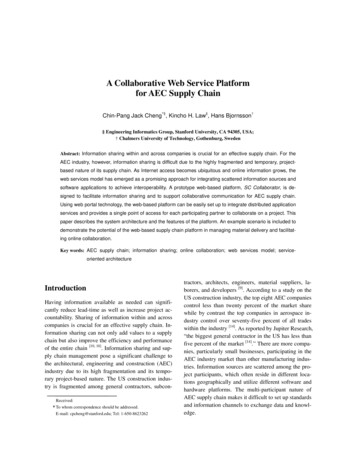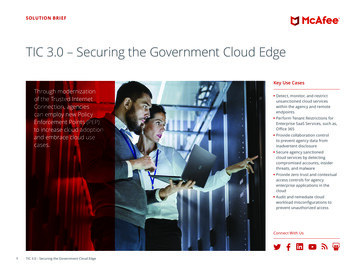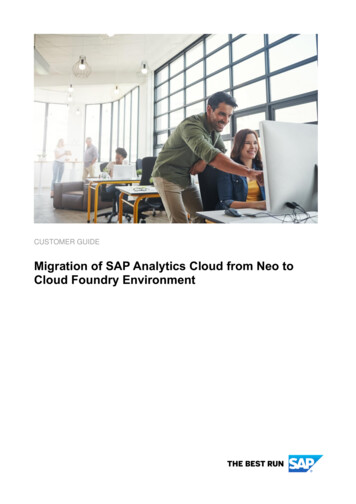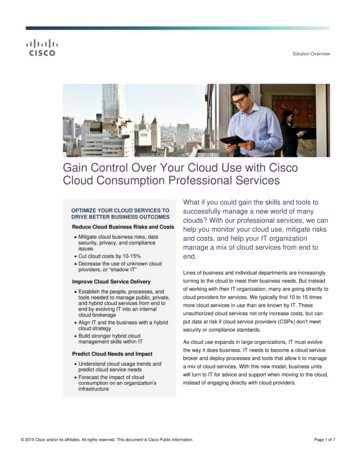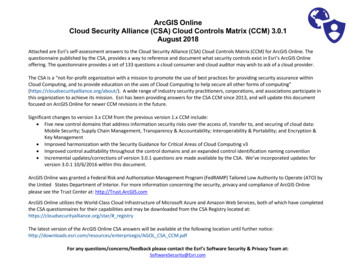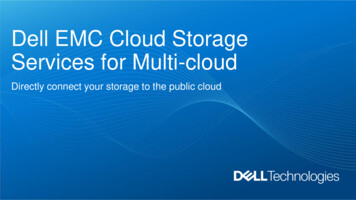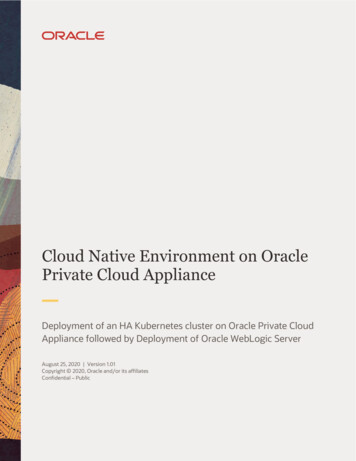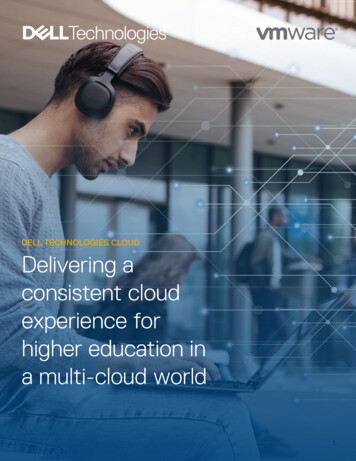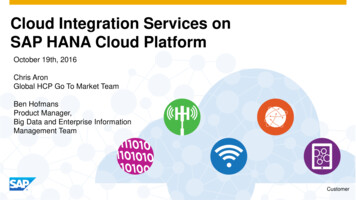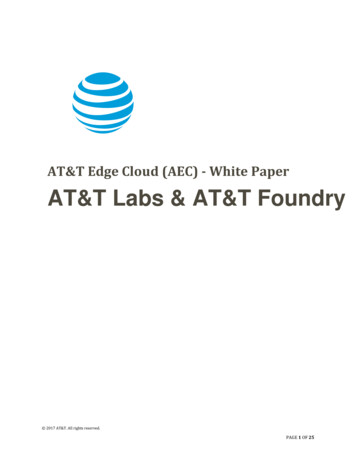
Transcription
AT&T Edge Cloud (AEC) - White PaperAT&T Labs & AT&T Foundry 2017 AT&T. All rights reserved.PAGE 1 OF 25
AT&T Edge Cloud (AEC)Table of ContentsI.Executive Summary. 4II.Background – Cloud Computing Evolution andthe Rise of the Edge Cloud . 6III.AT&T Edge Cloud Architecture . 11IV.Edge Computing Drivers . 13V.Edge Location Tradeoffs . 13VI.Edge Computing Use Cases . 14VII. Co-existence of Centralized Cloud and Edgecompute . 15VIII. Edge Computing Key Requirements . 16IX.Virtualization Infrastructure Manager (VIM). 17X.Scaling Edge Functions Using Cloud NativeComputing . 19XI.Orchestration & Management . 21XII. Open Source Eco-system – Edge Computingenablers . 21XIII. Conclusion . 22XIV. Glossary . 22XV. References. 24 2017 AT&T. All rights reserved.PAGE 2 OF 25
AT&T Edge Cloud (AEC) 2017 AT&T. All rights reserved.PAGE 3 OF 25
AT&T Edge Cloud (AEC)Executive SummaryIn recent years, there has been a concerted effort among all companies to move theirinfrastructure to a centralized cloud, enabled by virtualization. This push started with thevision of reducing time to market for new services and achieving lower total cost ofownership (TCO). This surge in the demand for cloud computing led providers like Amazonand Google to build massive centralized clouds (think data centers) designed for efficiency.With the emergence of new technologies such as augmented and virtual reality,autonomous cars, drones and IOT with smart cities, data is increasingly being produced atthe user end of the network. These use cases demand real-time processing andcommunication between distributed endpoints, creating the need for efficient processing atthe network edge.“Edge computing” is the placement of processing and storage capabilities near theperimeter (i.e., “edge”) of a provider’s network. Edge computing can be contrasted with thehighly-centralized computing resources of cloud service providers and web companies.Edge computing brings multiple benefits to telecommunications companies: reducing backhaul traffic by keeping right content at the edge, maintaining Quality of Experience (QoE) to subscribers with edge processing, reducing TCO by decomposing and dis-aggregating access functions, reducing cost by optimizing the current infrastructure hosted in central offices withlow cost edge solutions, improving the reliability of the network by distributing content between edge andcentralized datacenters, creating an opportunity for 3rd party cloud providers to host their edge clouds onthe telco real estate.The computational resources can be distributed geographically in a variety of locationtypes (e.g., central offices, public buildings, customer premises, etc.,) depending on the usecase requirements. This variety requires flexibility in the hardware and software design to 2017 AT&T. All rights reserved.PAGE 4 OF 25
AT&T Edge Cloud (AEC)accommodate constraints around power, space, security, and other elements. Therefore,edge computing needs to support any type of compute, storage and network (e.g.,peripherals, uCPE, COTS, white box, etc.)AT&T’s Domain 2.0 (D2) initiative has always followed a hybrid cloud deployment model tokeep latency sensitive network and service functions closer to the edges of the network andmove non-“real-time” applications to centralized data centers. This type of planning anddeployment method is well-known, and has been adopted by most global telco operators.This model can also be adapted to edge computing and edge-friendly workloads. We willmore than double our D2 AIC compute capacity in 2017. These new edge applications needto be geographically close to users, on a typical scale of hundreds to multiple thousands ofedge cloud deployments. At that scale, cost-effectiveness is key, along with native supportfor acceleration and peripherals.There are multiple edge open source and standard initiatives (e.g., ONAP [i], Open Stack[ii], ONF [vii], CNCF [iii], ETSI MEC [iv], OPNFV [viii], Open Compute Project [ix], xRAN [x],3gpp[xi], etc.,) that are converging to create an ecosystem that will support edge computingand edge services. The purpose of this whitepaper is to articulate the business andtechnical benefits of edge computing, describe edge technologies and solutions forsuppliers, and identify emerging potential business opportunities with 3rd party cloudproviders. Further, we establish a consortium proposal for global commonality such thatoperators, open source communities and standards bodies can realize next generationapplications such as augmented and virtual reality (AR/VR), self-driving vehicles, IOT, andmore. 2017 AT&T. All rights reserved.PAGE 5 OF 25
AT&T Edge Cloud (AEC)Background – Cloud Computing Evolution and theRise of the Edge CloudCloud resources have democratized access to computing and dramatically increased the paceof disruptive innovationClayton Christensen’s concept of the ‘innovator’s dilemma’ has been an axiomatic principlethroughout the rise of enterprise and consumer software markets [i]. In his 1997 book,Christensen describes the process by which a novel product or service can initially take root inan underserved fringe market, but then eventually grow to out-perform and disrupt theincumbent players in established markets as well (Figure 1). The incumbents – especially larger,less agile enterprises – are thus faced with the ‘dilemma’ of allocating sufficient resources tomaintain their competitive edge against potential disruptors while simultaneously increasingperformance along the dimensions that their mainstream customers have historically valued.[ii]Though applicable to almost any industry, this concept has been incredibly relevant in therapidly-evolving software and technology space.[i]Over the last decade, public cloud providers have dramatically increased both the pace and theimpact of disruptive innovation by allowing third party services to reap the benefits ofgeographic presence and economies of scale without deploying and maintaining their owncostly infrastructure. Public clouds have contributed to the success of new business models –facilitating the disruption of the television and movie industry, the disruption of the hotelindustry, etc. [iii] – and are rapidly attracting established companies as well.[iv]Figure 1: Impact of disruptive innovation upon new and existing markets [iii] 2017 AT&T. All rights reserved.PAGE 6 OF 25
AT&T Edge Cloud (AEC)However, the emergence of the public cloud has been revolutionary beyond just the startupand software communities; it has also introduced a new paradigm by which large-scaleenterprises can thrive in an increasingly fast-paced, software-driven economy. Public cloudcompanies have leveraged the sizeable investments made toward their own computinginfrastructure to create pay-as-you-go service environments for third-party players.[v] Bypowering some of the most innovative companies in the world with their Infrastructure as aService (IaaS) model, these cloud providers are becoming important participants in any newtechnology trend and effectively sharing in the financial growth and success of each of theircustomers.[i] And while incumbents in the software and service space are increasinglydisrupted, cloud infrastructure players have maintained a steady presence.[v] Thus, a largeenterprise can do more than merely avoid being disrupted by new technologies. By leveragingits infrastructure capabilities as a service to enable the growth of emerging ecosystems, it can infact share in their success.The public cloud was itself a disruptive initiative. When the first major cloud provider initiallylaunched, their service significantly underperformed the private data centers that were the goldstandard for established enterprises. [iv] However, rather than competing for these mainstreamcustomers, they gained traction by designing toward underserved markets, identifying newcustomers and use cases that were ill-suited for existing infrastructure paradigms. Over time,the offering adapted and grew dramatically, eventually leading even large IT companiesrelinquish their private data centers. [iv] We believe AT&T must also design toward new,underserved use cases as we evolve our business models and infrastructure into the 5G era.The IT-Networking Convergence Has Unlocked the Power of the CloudAs technology has evolved and converged, the flow of information has become streamlined,driving compute and storage off personal devices while simultaneously enabling them tobecome more powerful and intuitive with each subsequent generation. However, computingrevolutions are not a byproduct of the device technology alone – the entire ecosystem andinfrastructure must be developed to support these seismic shifts (Figure 2).In the 1990s, telecommunications companies (telcos), which previously offered primarilydedicated point-to-point data circuits, began to offer Virtual Private Network (VPN) services.Rather than building out physical infrastructure to allow for more users to have their ownconnections, telcos were now able to provide users with shared access to the same materialresources. Because these operators could optimize resource utilization toward overallbandwidth usage efficiency, they could offer the same quality of service at a fraction of the 2017 AT&T. All rights reserved.PAGE 7 OF 25
AT&T Edge Cloud (AEC)cost. In these early stages, the term “cloud” was used to represent the computing spacebetween the provider and the end user. In 1997, Professor Ramnath Chellapa of EmoryUniversity defined cloud computing as the new “paradigm where the boundaries of computingare determined by economic rationale rather than technical limits alone.” This has become thebasis of what we refer to today when we discuss the concept of cloud resources.[vi]1990s2000s2010s2020sVirtual Private NetworksEnterprise ServersDominantRemoteApplica onServerApparent‘Distance’Decreased byImproved alized Cloud CDNsEdge CloudDial-UpDSL4G LTE WLAN5G WLANHead-mounted DisplayDominantPersonalCompu ngParadigmSmartphoneLaptopPCFigure 2: History and future projections of the IT-Networking convergenceAs computers became ubiquitous, engineers and technologists explored ways to make largescale cloud computing power available to more users through time-sharing. They experimentedwith algorithms to optimize the infrastructure, platforms, and applications to prioritizecomputing resources and increase efficiency for end users. In the 2000s, major movers in thecloud arena pioneered the concept of delivering enterprise-level applications to end users viathe Internet.[vii] Over time, the IT-Networking ecosystem has become increasingly adept anddynamic. Cloud data centers have become more powerful and geographically distributed, andnetworks have become dramatically more efficient in order to support them. As a result,remote application servers have become easier to access, bringing more information, mediacontent, utility applications, and realistic forms of communication directly to the consumer.Content Delivery Networks Brought Static Content to the Edge 2017 AT&T. All rights reserved.PAGE 8 OF 25
AT&T Edge Cloud (AEC)Content Delivery Networks (CDNs) play a critical role in the seemingly immediate contentaccess that users experience today by establishing Points of Presence (POPs) that storelocalized caches of content geographically nearer to end users. By hosting these large contentfiles at the edge of the network, CDNs are also able to alleviate performance variance, corenetwork congestion, and high operating expenses for massive data transmission.Due to the increased streaming demands of the past few years, large content providers haveexplored models to further improve performance and reduce delivery cost. By establishingcommercial agreements directly with local and regional network operators, they can place theirown CDNs within the operator network itself, eliminating the delays induced by transferring toan external InP. These large CDN providers are continuously expanding their geographicpresence.[iii]The Emergence of the Compute-Driven Edge CloudWhile CDNs significantly improve user access of static, predefined content such as videos andweb pages, they are not designed to be application servers for dynamic content such as AR/VR,real-time analytics, etc. CDNs essentially operate as caches for content files that they pull fromtheir central origin server[vii] and are not equipped with the requisite computing infrastructureto dynamically generate content streams.[viii]Pseudo-dynamic (sometimes referred to as ‘event-driven’) co
cloud arena pioneered the concept of delivering enterprise-level applications to end users via the Internet.[vii] Over time, the IT-Networking ecosystem has become increasingly adept and dynamic. Cloud data centers have become more powerful and geographically distributed, and networks have become dramatically more efficient in order to support .

